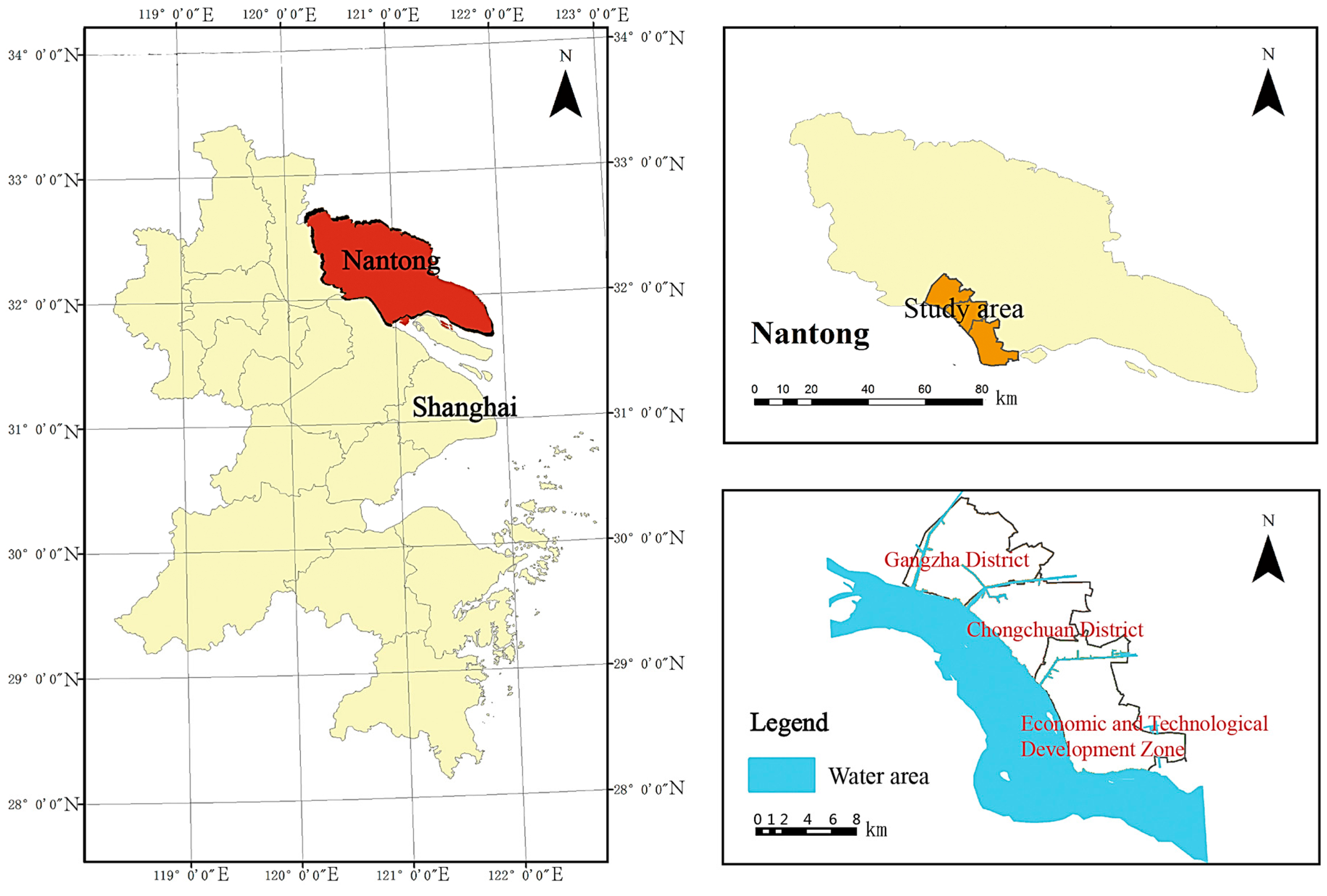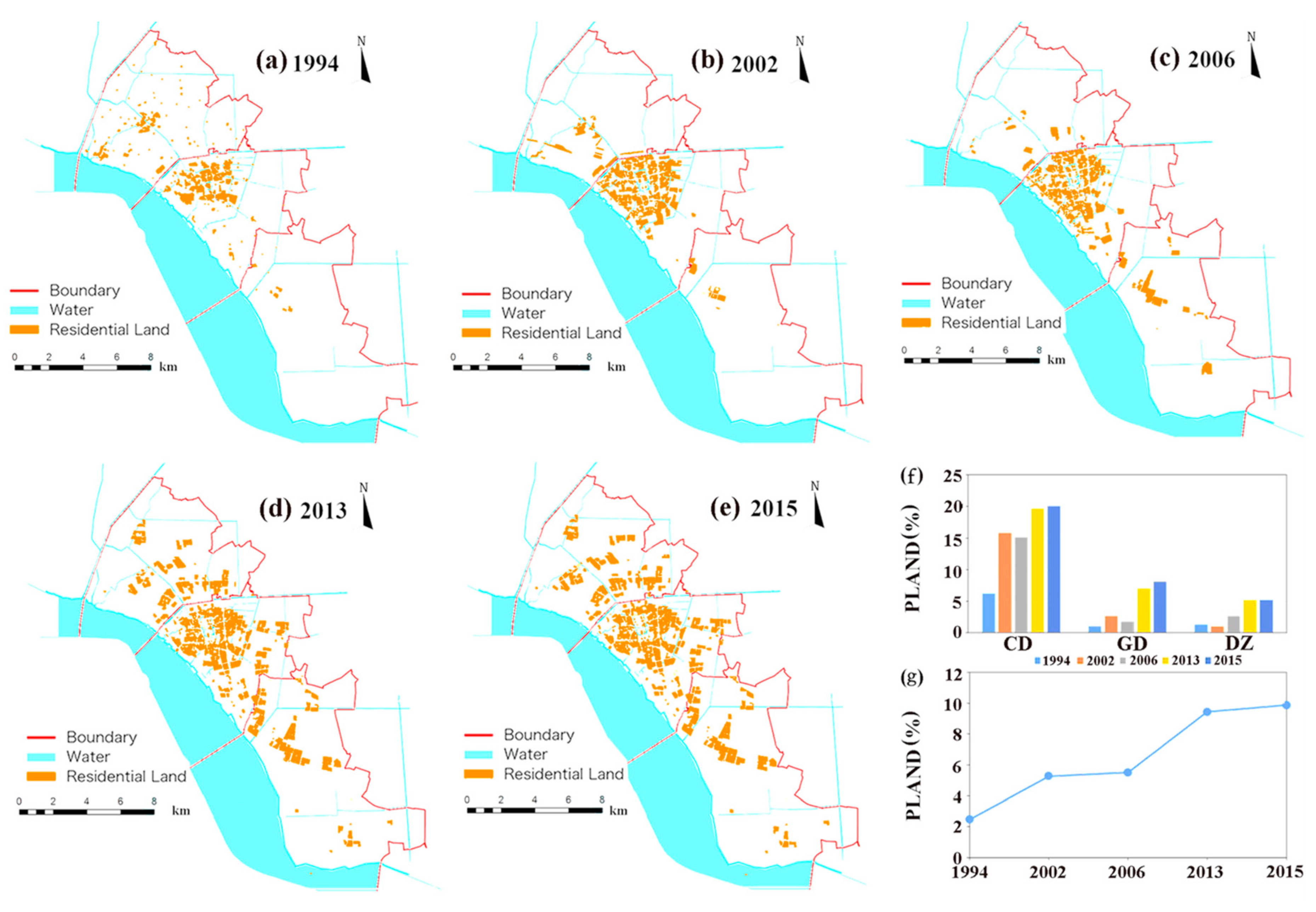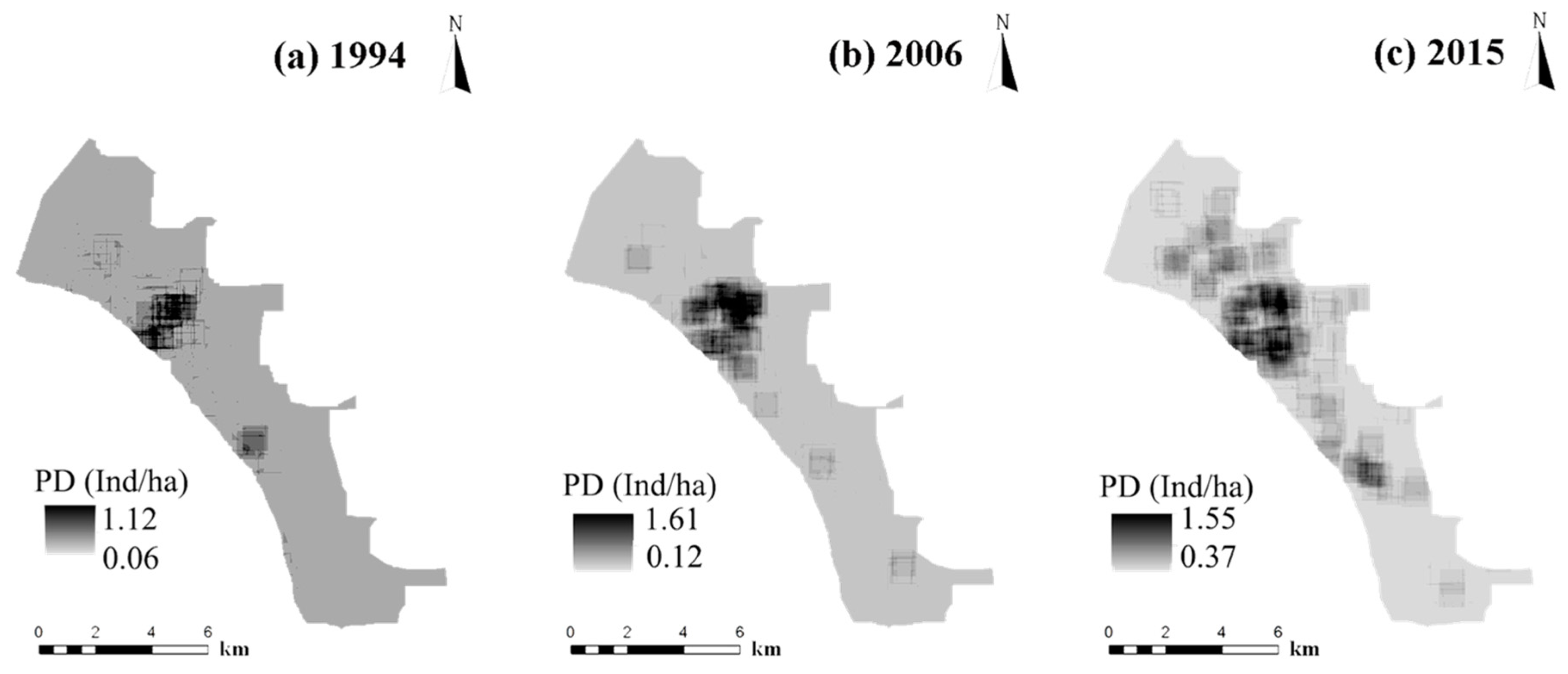Spatiotemporal Fragmentation of Urban Residential Land Use: A Case Study from China
Abstract
:1. Introduction
2. Methods and Data
2.1. Study Area
2.2. Data Source and Processing
2.3. Landscape Metrics
2.4. Variables to Describe the Potential Driving Forces
2.5. Moving Window Analysis Approach
3. Results
3.1. The Expansion of Residential Land Use in Nantong City
3.2. The Spatial Evolution of Residential Land Use Fragmentation
3.3. The Evolution Characteristics of Residential Land Use Fragmentation from a City Morphology Perspective
3.4. Driving Forces of Residential Land Use Fragmentation in Nantong City
4. Discussion
4.1. The Relationship between the Fragmentation of Residential Land Use and Urbanization
4.2. The Spatial Characteristics of Residential Land Use Fragmentation
4.3. The Dynamic Mechanisms of Residential Land Use Fragmentation in Nantong
4.4. Application to Urban Residential Land Use
5. Conclusions
Acknowledgments
Author Contributions
Conflicts of Interest
References
- National Bureau of Statistics of China (NBSC). China Statistical Yearbook; China Statistics Press: Beijing, China, 2014.
- Shrestha, M.K.; York, A.M.; Boone, C.G. Land fragmentation due to rapid urbanization in the Phoenix Metropolitan Area: Analyzing the spatiotemporal patterns and drivers. Appl. Geogr. 2012, 2, 522–531. [Google Scholar] [CrossRef]
- Liu, Y.; Yue, W.; Fan, P. Suburban residential development in the era of market-oriented land reform: The case of Hangzhou, China. Land Use Policy 2015, 42, 233–243. [Google Scholar] [CrossRef]
- Li, T. Land use dynamics driven by rural industrialization and land finance in the peri-urban areas of China: “The examples of Jiangyin and Shunde”. Land Use Policy 2015, 45, 117–127. [Google Scholar]
- Jabareen, Y.R. Sustainable urban forms: Their typologies, models, and concepts. J. Plan. Educ. Res. 2006, 26, 38–52. [Google Scholar] [CrossRef]
- Xie, Q.; Parsa, A.R.G.; Redding, B. The emergence of the urban land market in China: Evolution, structure, constraints and perspectives. Urban Stud. 2002, 39, 1375–1398. [Google Scholar] [CrossRef]
- Saunders, D.A.; Hobbs, R.J.; Margules, C.R. Biological consequences of ecosystem fragmentation: A review. Conserv. Biol. 1991, 5, 18–32. [Google Scholar] [CrossRef]
- Carsjens, G.J.; van Lier, H.N. Fragmentation and land-use planning—An introduction. Landsc. Urban Plan. 2002, 28, 79–82. [Google Scholar] [CrossRef]
- Fahrig, L. Effects of habitat fragmentation on biodiversity. Annu. Rev. Ecol. Evol. Syst. 2003, 34, 487–515. [Google Scholar] [CrossRef]
- Weng, Y.-C. Satiotemporal changes of landscape pattern in response to urbanization. Landsc. Urban Plan. 2007, 81, 341–353. [Google Scholar] [CrossRef]
- Wei, Y.P.; Zhang, Z.Y. Assessing the fragmentation of construction land in urban areas: An index method and case study in Shunde, China. Land Use Policy 2012, 29, 417–428. [Google Scholar] [CrossRef]
- You, H.Y. Quantifying urban fragmentation under economic transition in Shanghai city, China. Sustainability 2016, 8, 21. [Google Scholar] [CrossRef]
- Tan, S.H.; Heerink, N.; Qu, F.T. Land fragmentation and its driving forces in China. Land Use Policy 2006, 23, 272–285. [Google Scholar] [CrossRef]
- Yu, X.J.; Ng, C.N. Spatial and temporal dunamics of urban sprawl along two urban-rural transects: A case study of Guangzhou, China. Landsc. Urban Plan. 2007, 79, 96–109. [Google Scholar] [CrossRef]
- York, A.M.; Shrestha, M.K.; Boone, C.G.; Zhang, S.; Harrington, J.A.; Prebyl, T.J.; Swann, A.; Agar, M.; Antolin, M.F.; Nolen, B.; et al. Land fragmentation under rapid urbanization: A cross-site analysis of Southwestern cities. Urban Ecosyst. 2011, 14, 429–455. [Google Scholar] [CrossRef]
- Feng, L.; Li, H. Spatial pattern analysis of urban sprawl: Case study of Jiangning, Nanjing, China. J. Urban Plan. Dev. 2012, 138, 263–269. [Google Scholar] [CrossRef]
- Inostroza, L.; Baur, R.; Csaplovics, E. Urban sprawl and fragmentation in Latin America: A dynamic quantification and characterization of spatial patterns. J. Environ. Manag. 2013, 115, 87–97. [Google Scholar] [CrossRef] [PubMed]
- Zhang, Z.H.; Tu, Y.J.; Li, X. Quantifying the spatiotemporal patterns of urbanization along urban-rural gradient with a roadscape transect approach: A case study in Shanghai, China. Sustainability 2016, 8, 862. [Google Scholar] [CrossRef]
- Gustafson, E. Quantifying landsacpe spatial pattern: What is the state of the art? Ecosystems 1998, 2, 143–156. [Google Scholar] [CrossRef]
- Su, S.; Jiang, Z.; Zhang, Q.; Zhang, Y. Transformation of agricultural landscapes under rapid urbanization: A threat to sustainability in Hang-Jia-Hu region, China. Appl. Geogr. 2011, 31, 439–449. [Google Scholar] [CrossRef]
- Su, S.; Wang, Y.; Luo, F.; Mai, G.; Pu, J. Peri-urban vegetated landscape pattern changes in relation to socioeconomic development. Ecol. Indic. 2014, 46, 477–486. [Google Scholar] [CrossRef]
- Chen, J.; Chang, K.; Karacsonyi, D.; Zhang, X. Comparing urban land expansion and its driving factors in Shenzhen and Dongguan, China. Habitat Int. 2014, 43, 61–71. [Google Scholar] [CrossRef]
- Gibbs, J.P. Distribution of woodland amphibians along a forest fragmentation gradient. Landsc. Ecol. 1998, 13, 263–268. [Google Scholar] [CrossRef]
- Abdullah, S.A.; Nakagoshi, N. Forest fragmentation and its correlation to human land use change in the state of Selangor, Peninsular Malaysia. For. Ecol. Manag. 2007, 241, 39–48. [Google Scholar] [CrossRef]
- Tian, Y.; Jim, C.Y.; Tao, Y.; Shi, T. Landscape ecological assessment of green space fragmentation in Hong Kong. Urban For. Urban Green. 2011, 10, 79–86. [Google Scholar] [CrossRef]
- Nantong Statistical Bureau. Nantong Statistical Yearbook; China Statistics Press: Beijing, China, 1994–2015.
- Jiangsu Bureau of Statistics of China (NBSC). China Statistical Yearbook; China Statistics Press: Beijing, China, 2015.
- Fangfang, C.; Lijie, P.; Ming, Z. Assessment framework and decision—Support System for consolidating urban-rural construction land in coastal China. Sustainability 2014, 6, 7689–7709. [Google Scholar]
- Tian, G.; Jiang, J.; Yang, Z.; Zhang, Y. The urban growth, size distribution and spatio-temporal dynamic pattern of the Yangtze River Delta megalopolitan region, China. Ecol. Model. 2011, 222, 865–878. [Google Scholar] [CrossRef]
- ESRI. Arcgis Desktop: Release 10; Environmental Systems Research Institute: Redlands, CA, USA, 2011. [Google Scholar]
- McGarigal, K.; Marks, B.J. Spatial Pattern Analysis Program for Quantifying Landscape Structure; Genneral Technical Reporet PNW-GTR-351; US Department of Agriculture, Forest Service, Pacific Northwest Research Station: Portland, OR, USA, 1995.
- Lu, S.S.; Guan, X.L.; He, C.; Zhang, J.L. Spatio-temporal patterns and policy implications of urban land expansion in metropolitan areas: A case study of Wuhan urban agglomeration, central China. Sustainability 2014, 6, 4723–4748. [Google Scholar] [CrossRef]
- Qu, F.; Heerink, N.; Wang, W. Land administration reform in China: Its impact on land allocation and economic development. Land Use Policy 1995, 12, 193–203. [Google Scholar] [CrossRef]
- Wei, Y.H.D.; Li, W.M. Reforms, globalization, and urban growth in China: The case of Hangzhou. Eurasian Geogr. Econ. 2002, 43, 459–475. [Google Scholar] [CrossRef]
- Riitters, K.H.; Wickham, J.D.; O’Neill, R.V.; Jones, K.B.; Smith, E.R.; Coulston, J.W. Fragmentation of continental United States forests. Ecosystems 2002, 5, 815–822. [Google Scholar] [CrossRef]
- Long, H.; Zou, J.; Pykett, J.; Li, Y. Analysis of rural transformation development in China since the turn of the new millennium. Appl. Geogr. 2011, 31, 1094–1105. [Google Scholar] [CrossRef]
- Herold, M.; Scepan, J.; Clarke, K.C. The use of remote sensing and landscape metrics to describe structures and changes in urban land uses. Environ. Plan. A 2002, 34, 1443–1458. [Google Scholar] [CrossRef]
- Wu, J.; Jenerette, G.D.; Buyantuyev, A.; Redman, C.L. Quantifying spatiotemporal patterns of urbanization: The case of the two fastest growing metropolitan regions in the United States. Ecol. Complex. 2011, 8, 1–8. [Google Scholar] [CrossRef]
- Liu, Z.F.; He, C.Y.; Wu, J.G. General spatiotemporal patterns of urbanization: An examination of 16 world cities. Sustainability 2016, 8, 41. [Google Scholar] [CrossRef]
- Seto, K.C.; Fragkias, M. Quantifying spatiotemporal patterns of urban land-use change in four cities of China with time series landscape metrics. Landsc. Ecol. 2005, 20, 871–888. [Google Scholar] [CrossRef]
- Feng, L.; Du, P.J.; Li, H.; Zhu, L.J. Measurement of urban fringe sprawl in Nanjing between 1984 and 2010 using multidimensional indicators. Geogr. Res. 2015, 53, 184–198. [Google Scholar] [CrossRef]
- Zhang, T. Community features and urban sprawl: The case of the Chicago metropolitan region. Land Use Policy 2001, 18, 221–232. [Google Scholar] [CrossRef]
- Liu, Y.; Yue, W.; Fan, P. Spatial determinants of urban land conversion in large Chinese cities: A case of Hangzhou. Environ. Plan. B Plan. Des. 2011, 38, 706–725. [Google Scholar] [CrossRef]
- Zhou, Y.; Ma, L. Economic restructuring and suburbanization in China. Urban Geogr. 2000, 21, 205–236. [Google Scholar] [CrossRef]
- Yang, J.; Sun, J.; Zhao, H.D.; Xi, J.C.; Li, X.M. Spatio-temporal differentiation of residential land for coastal town: A case study of Dalian Jinshitan. Chin. Geogr. Sci. 2016, 26, 566–576. [Google Scholar] [CrossRef]
- Feng, J.; Zhou, Y. Suburbanization and the changes of urban internal spatial structure in Hangzhou, China. Urban Geogr. 2005, 26, 107–136. [Google Scholar] [CrossRef]
- Yue, W.Z.; Zhang, L.L.; Liu, Y. Measuring sprawl in large Chinese cities along the Yangtze River via combined single and multidimensional metrics. Habitat Int. 2016, 57, 43–52. [Google Scholar] [CrossRef]




| Metrics (Abbreviation) | Formula and Description | Range |
|---|---|---|
| Percentage of landscape (PLAND) | PLAND = PLAND equals the proportion of total residential area. It measures the size of a residential area | 0 ≤ PLAND ≤ 100 |
| Patch density (PD) | PD = PD equals the number of residential land use patches per area. It measures residential land use fragmentation | PD > 0, without limit |
| Landscape shape index (LSI) | LSI = LSI equals edge density adjusted for size of the landscape. It is a measure of residential land use patch shape complexity | LSI ≥ 1, without limit |
| Patch cohesion index (COHE) | COHE = COHE equals the aggregation or clumping of cover types into patches. It is a measure of the physical connectedness of residential land use patches | 0 ≤ COHE ≤ 100 |
| Dimension | Variable | Description |
|---|---|---|
| Socio-economic | Gross domestic product (GDP) | Total amount of economy |
| Total retail sales of social consumer goods (SCG) | Total volume of domestic consumption demand | |
| Governance | Total investment in fixed assets (IFA) | Total volume of construction and acquisition of fixed assets |
| Added value of tertiary industry/added value of secondary industry (ATI) | Ratio of increase in output value between tertiary and secondary industries | |
| Globalization | Import-export value (IEV) | Total size of external trade |
| Total foreign capital in actual use (TFU) | Total volume of foreign capital utilization |
| Regression | Adjust R2 |
|---|---|
| PD = 0.22 + 1.37 × ATI | 0.77 *** |
| LSI = 0.37 + 1.08 × ATI + 0.42 × TFU | 0.72 *** |
| COHE = −0. 01 − 0.95 × ATI | 0.74 *** |
| PLAND = 0.29 + 1.38 × ATI | 0.83 *** |
© 2017 by the authors. Licensee MDPI, Basel, Switzerland. This article is an open access article distributed under the terms and conditions of the Creative Commons Attribution (CC BY) license (http://creativecommons.org/licenses/by/4.0/).
Share and Cite
Liu, X.; Liu, H.; Chen, W.; Zhang, Z. Spatiotemporal Fragmentation of Urban Residential Land Use: A Case Study from China. Sustainability 2017, 9, 1096. https://doi.org/10.3390/su9071096
Liu X, Liu H, Chen W, Zhang Z. Spatiotemporal Fragmentation of Urban Residential Land Use: A Case Study from China. Sustainability. 2017; 9(7):1096. https://doi.org/10.3390/su9071096
Chicago/Turabian StyleLiu, Xue, Helin Liu, Wanzhen Chen, and Zhonghao Zhang. 2017. "Spatiotemporal Fragmentation of Urban Residential Land Use: A Case Study from China" Sustainability 9, no. 7: 1096. https://doi.org/10.3390/su9071096




